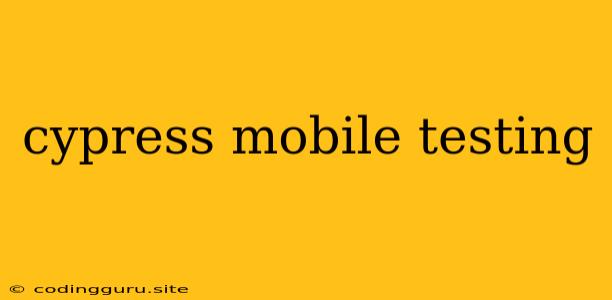Cypress Mobile Testing: A Comprehensive Guide
Mobile testing is crucial for ensuring a seamless user experience across diverse devices. Cypress, a popular JavaScript testing framework, offers a robust solution for efficient and reliable mobile testing. But how can you leverage Cypress for mobile testing? Let's dive into the intricacies of this powerful approach.
Why Choose Cypress for Mobile Testing?
Cypress stands out as a top choice for mobile testing due to its numerous advantages:
- Easy Setup and Integration: Cypress simplifies the testing process with its user-friendly setup and seamless integration with popular frameworks like React, Angular, and Vue.js.
- Real-Time Feedback: Cypress provides instant visual feedback, allowing developers to quickly identify and fix bugs.
- Automated Testing: Cypress empowers automated testing, enabling you to run tests repeatedly and catch regressions early on.
- Cross-Browser Support: Cypress supports a wide range of browsers, ensuring your application works flawlessly across different platforms.
- Fast Execution: Cypress executes tests rapidly, minimizing wait times and accelerating the development cycle.
How to Set Up Cypress for Mobile Testing
Setting up Cypress for mobile testing involves a few essential steps:
-
Install Cypress: Begin by installing Cypress using the following command:
npm install cypress --save-dev -
Configure Cypress: Open the
cypress.config.jsfile and configure the browser you wish to use for mobile testing. For example:module.exports = defineConfig({ e2e: { baseUrl: 'http://localhost:3000', setupNodeEvents(on, config) { // implement node event listeners here }, viewportHeight: 600, viewportWidth: 375, chromeWebSecurity: false, // This is important to prevent cross-origin errors in Cypress browser: 'chrome' // Change to your desired browser }, });- viewportHeight and viewportWidth simulate mobile device dimensions.
- chromeWebSecurity: This setting disables cross-origin security, essential for mobile testing.
-
Run Cypress: Execute Cypress tests using the command:
npx cypress open
Best Practices for Effective Mobile Testing with Cypress
To maximize the effectiveness of your mobile testing with Cypress, follow these best practices:
- Use Real Devices or Emulators: For accurate results, test on real devices or emulators that mimic the target platform's behavior.
- Test Across Different Mobile Browsers: Ensure your app functions seamlessly across major browsers like Chrome, Safari, Firefox, and Edge.
- Focus on Mobile-Specific Features: Test features that are unique to mobile devices, such as touch interactions, geolocation, and camera access.
- Prioritize Performance Testing: Mobile users expect fast-loading applications. Optimize your app for performance using Cypress's performance testing capabilities.
- Consider Accessibility Testing: Ensure your app is accessible to users with disabilities by performing accessibility checks using Cypress.
Example Cypress Test for Mobile Functionality
describe('Mobile Login', () => {
it('should successfully log in using a mobile device', () => {
cy.viewport('iphone-6'); // Simulate iPhone 6 screen size
cy.visit('/login');
cy.get('#username').type('testuser');
cy.get('#password').type('testpassword');
cy.get('#login-button').click();
cy.url().should('include', '/dashboard'); // Verify successful login
});
});
Conclusion
Cypress provides a powerful and efficient framework for mobile testing, enabling developers to ensure a seamless user experience across diverse devices. By following the best practices and leveraging Cypress's capabilities, you can deliver high-quality mobile applications that meet user expectations.
